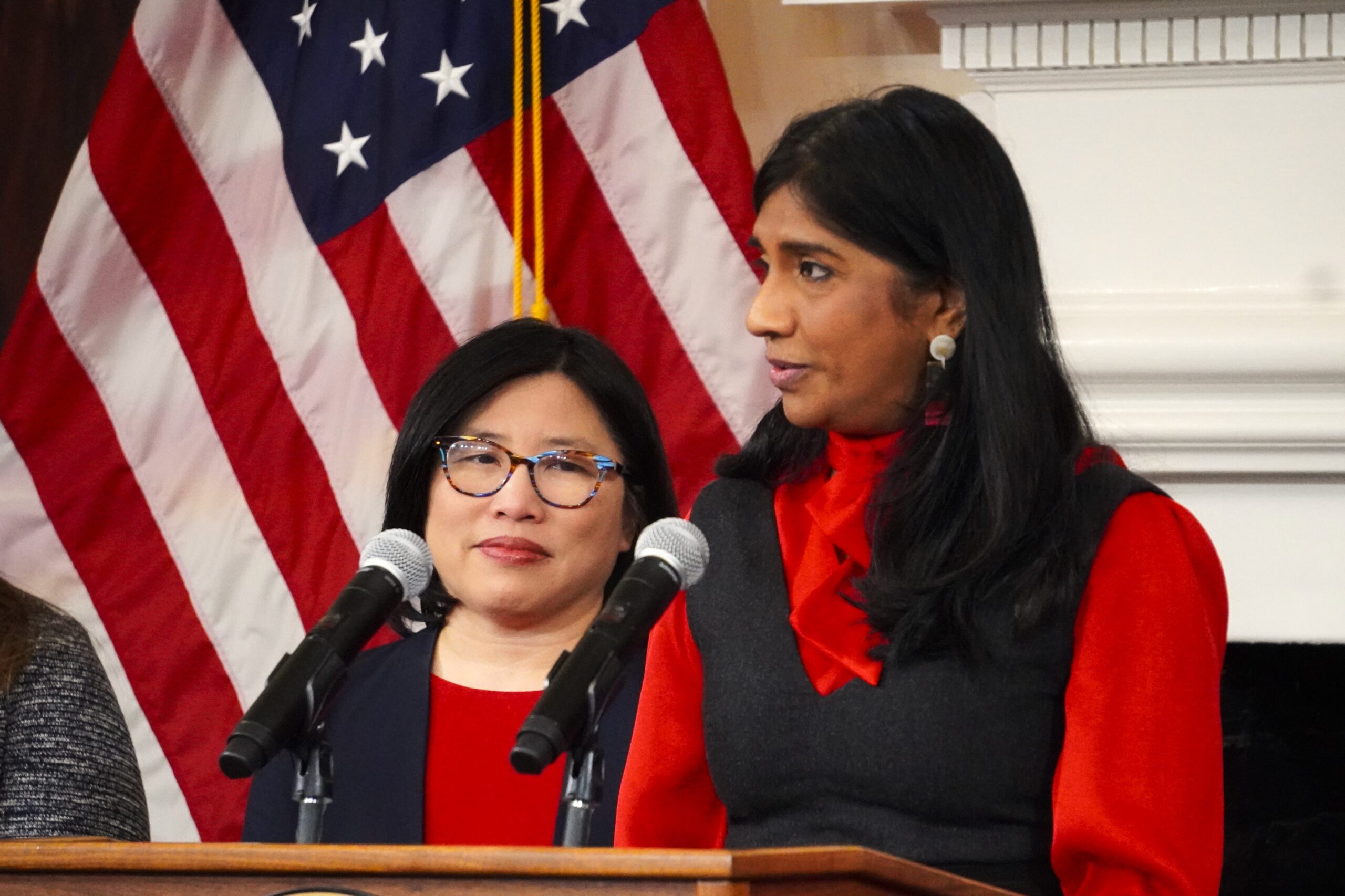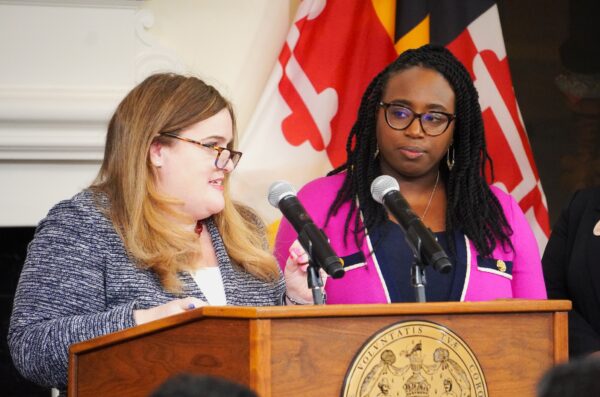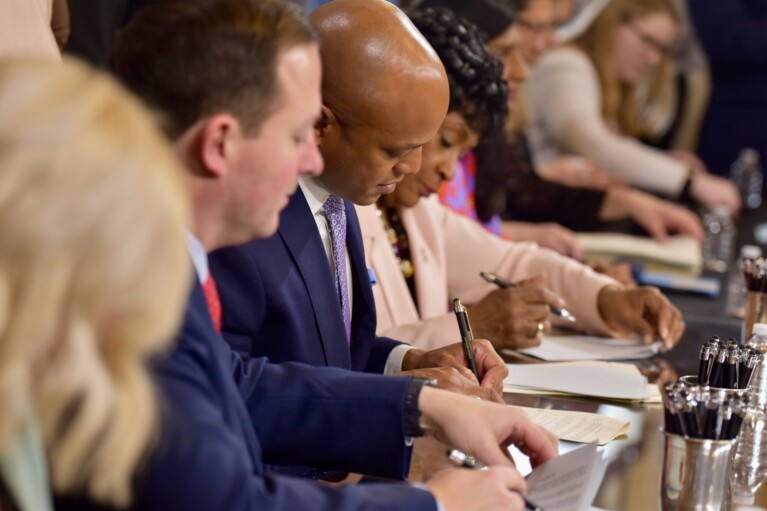Women earn less than men throughout Md.; lawmakers say wage transparency may help

Maryland still has a long way to go to close what’s known as the “gender pay gap,” which highlights the wage disparity between men and women’s median earnings.
Lt. Gov. Aruna Miller (D) and some members of the Maryland General Assembly hope to chip away at the issue with legislation on wage transparency during this session.
“This is a month in which we celebrate the achievements of women and to really amplify the challenges that women continue to experience…This is an issue of basic fairness and this is an issue of economic strength,” Miller said at a State House news conference Tuesday. March is Women’s History Month.
Miller’s comments reflect findings from a recent gender wage gap report out of the Maryland Department of Labor, using data from the U.S. Census’ American Community Survey and U.S. Bureau of Labor Statistics.
The department’s “Equal Pay Day Report,” released Tuesday, provides a snapshot of the gender pay gap throughout Maryland.
While Maryland tends to have a smaller than average pay gap between men and women compared to the national perspective, Miller says that the report “sheds a lot of light on the challenges we still need to overcome here.”
Overall, women in Maryland earn 86 cents for every dollar that a man makes. Nationally, women make 81 cents to every dollar a man earns.
The disparity increases when factoring in race and other demographic considerations.
“Maryland cannot win if Maryland women make 86 cents to a man’s dollar. Maryland cannot win if Black Maryland women make 67 cents to a man’s dollar,” Miller said. “And Maryland cannot win if Hispanic Maryland women make 50 cents to a man’s dollar.”
The factors that contribute to the disparity in pay between men and women are multi-faceted and can vary by county, the report shows.
“The size of the overall gender pay gap varies from county to county, based on a number of factors including demographic characteristics and industry concentrations. Since Black and Latino men, in particular, also experience a wage gap when compared with white women, counties with higher percentage populations in these groups tend to see smaller differences between men and women as a whole.”
The report notes that Prince George’s County is the only jurisdiction where women out-earn men on average, as “women are paid $1.08 for every dollar a man makes.”
“This is due in part to the fact that Prince George’s County is a majority Black or African American county: 64.1% of the county’s population identifies as Black or African American. In Prince George’s County, Black or African American women’s median earnings are higher than Black or African American men and this brings the overall numbers down for men,” according to the report.
With Prince George’s County as an exception, Baltimore City has the smallest wage gap between men and women, with women earning 95 cents for every dollar a man makes.
But in Frederick County, a woman makes 79 cents to every dollar earned by a man. In Harford and Cecil counties, that wage gap is 76 cents to every dollar.
One of the greatest disparities identified in the report is found in Montgomery County, where a Hispanic/Latina woman makes 36 cents to every dollar a white, non-Hispanic man earns. In Howard and Prince George’s counties, a Hispanic/Latina woman earns 41 cents to every dollar a white, non-Hispanic man makes.
Several factors contribute
The report identifies a few societal factors and trends that contribute to the gender wage gap data.
The report finds that Maryland women tend to be “crowded into,” or over-represented, in certain positions that do not pay as much.
“For a host of reasons including barriers to entry and inequities in opportunity, women — and especially women of color — are more likely to be concentrated in low-quality jobs that pay low-wages, have few benefits, and limited opportunities for advancement,” the report says.
These occupations include: maids and housekeeping, childcare workers, hairdressers and cosmetologists, nursing assistants, preschool and kindergarten teachers, receptionists and information clerks and dental assistants.
The median wages for these occupations range from $9,000 to $45,000 in Maryland, data shows.
Women are also “crowded out of” higher-wage jobs, including some of the most in-demand occupations in the state such as engineers, software developers and computer and information systems managers, the report says.
These jobs have median wages ranging from $90,000 to $136,700 in Maryland.
Another factor that contributes to the gender pay gap is “gendered caretaking responsibilities and expectations,” as women tend to take on more family care-giving responsibilities.
This results in women having fewer working hours than their male counterparts. If child-care options aren’t readily available, working women may take more-flexible but lower-paying jobs with fewer promotion opportunities.
The report also recognizes that pay gaps occur among other groups and can compound into more significant pay gaps. Other groups that face pay gaps include disabled employees, older workers, LGBTQ+ individuals, and military veterans, among others — though the analysis did not look into those groups specifically.
Wage transparency legislation

Sen. Ariana B. Kelly (D-Montgomery), left, and Del. Jennifer White Holland (D-Baltimore County) discuss wage disparities between men and women in Maryland at a news conference on March 12, 2024. Photo by Danielle J. Brown.
The gender pay gap might be improved with wage transparency in job postings, according to the Labor Department report. That issue is at the center of legislation under consideration during the 2024 session.
“The wage gap lives in those intersections between sex discrimination and racial discrimination and class discrimination. It’s a form of discrimination that thrives when people lack information about the economic value of the work they’re applying to do,” said Sen. Ariana B. Kelly (D-Montgomery) at the Tuesday news conference.
She is a lead sponsor of Senate Bill 525, which would require employers to disclose potential salary range, benefits and other compensation information on any internal and public job postings.
Kelly says the bill would help reduce the gender pay gap by being upfront about an applicant’s potential earning opportunities in a particular job.
The full Senate will likely vote on SB 525 this week.
Del. Jennifer White Holland (D-Baltimore County) sponsors the House version, HB 649, which has not yet received a vote out of the House Economic Matters Committee.
“What I really like about this bill is that all parties are informed about the negotiation context. It creates a more equal playing field,” she said. “Transparency is always, always a good thing.”




 Creative Commons Attribution
Creative Commons Attribution